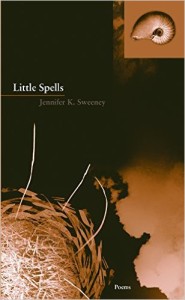Joannie Stangeland: “From the Back of Beyond” – Jennifer K. Sweeney’s Little Spells
 Little Spells
Little Spells
Jennifer K. Sweeney
New Issues Poetry & Prose, 2015
In Little Spells, Jennifer K. Sweeney journeys the switchback path between wanting a child and becoming a mother, her poems traveling through landscapes and families—including a collection of refocused fairy tales and a sonnet series titled “still life with egg.”
The title poem begins, “We are not witches as fable stoops us / hunchback over caldrons, not women / hobbled sinister by absence”, and goes on to detail an assortment of talismans—a closet altar, bowls of royal pollen, quartz turtles—and prayer-like resolutions: “flick last seeds / of air from a needle / and ease it into the womb.” The list of promising rituals presages “cliffside narrative,” a collection of fairy tales reinterpreted. As strange consequences erupt in Rapunzel or Sleeping Beauty, these poems fragment, refusing to coalesce. Whether fable, song, or instruction, these poems reveal and confront possibility, sorrow, and the anxiety that could lead someone to read field guides in the grocery store parking lot. They offer a catalog of sad endings—mothers who, as Sweeney remarks in her notes, disappear “with no further mention, infertility seeming to be a disposable and handy plot construction.”
While this book is grounded in fable and folklore, it suspects those stories and spells, acknowledging familiar outcomes while refusing to commit to them. In the third section, Sweeney continues to question cultural stigmas in “Doc Solves Mystery of Frida Kahlo’s Infertility” (an MSNBC headline):
You do not need to wax on about The Broken Column
or sit her down sixty years later in your patient seat
with the damaged flower of your diagnosis
blooming around you.
Sweeney studies other losses—“the red-tailed vireo weaving a nest…while cowbirds prey on her eggs / leaving the mother to mourn the disappeared”, the impending loss of sight in “Blindness Training Center,” and the mystery of Janice Pockett, a girl who vanished the same year the poet was born. Sweeney also introduces other families—the family of five “with a purpose specific / as the beachgrass knit // across the eroded dune” and the families of migrant workers, children’s hands “nimble enough to pluck blueberries / in noon heat without collapsing ripe skins” until the season ends and they “make their silent exodus / from the back of beyond.”
Many of the poems in Little Spells are set in winter and create a surreal season that reflects the uncertainty of waiting. Take these lines from “Winter, Parenthetical”:
I had wished to live in a country of bad weather and nested
inside a winter inside a winter inside a long night.
The repetition sets up ritual, as in a spell that binds a woman to the story she did not want. Repeated lines and images increase that sense. “Of all the things I was I was cold” is followed later by “Of all the things I was I was not.” And later: “We had to make calls to ask strangers to remove the obstacles” is followed by “We had to ask strangers to remove the obstacles.” The repetition would be a comfort, but the images and the variation are restless, the obstacles open to interpretation.
Then there’s the way Sweeney sculpts language and sound. In “On Not Being an Axeman,” she says:
Like the tree
etched with secrecy,
striations wound in a brindly mass,
grooveworks and spirals
grow crooked the unsplittable
How delicious “brindly” feels in the mouth—or listen to these lines from “White October”:
white October with its white pumpkins
and pearly pampas grass.
Thin as a plume
The repetition of white—not often associated with October or with pumpkins—and the alliteration and assonance, the “l” sounds of pearly and plume, lend this bleached season an underlying lushness, while “Thin as a plume” reminds us that the year is dying.
Just as any good magic requires the right ingredients, Sweeney charges her words’ potency by fusing them. In Hopkins, we find crush-silk, May-mess, rash-fresh, blue-bleak. Sweeney gives us grooveworks, fieldrush, neverlasting, god-quiet, clocksong, littlebluefish, and littlebigheart. The language creates its own phenomena that reject ordinary expectations of the witch, the spell, the nest and egg.
Beyond the images and their sounds, beyond the narrative and grief’s recurrences, the book’s silences startle. They invite the reader to listen. Rather than relying on pyrotechnical snazzy dazzle, the poems offer a fierceness that, to paraphrase Dickinson, stuns you by degrees.
Whether a known territory—a shared experience—or an unfamiliar realm, these poems lead the reader, almost as though strolling across a meadow where we find “the last cinders of dusk falling into place.” Suddenly night drops, the moon appears, and you see everything you’ve just passed differently, above and under the surfaces. Little Spells resonates with presence and emotional space—an amplitude that lets you breathe through each separate story, each anticipation and anguish, with the hard-won trust that the world will see spring again.
—
Joannie Stangeland is the author of In Both Hands and Into the Rumored Spring, both published by Ravenna Press, two chapbooks, and the pamphlet A Piece of Work. Her poems have also appeared in Front Porch Journal, Off the Coast, Hubbub, Santa Fe Literary Review, and other journals and anthologies.
